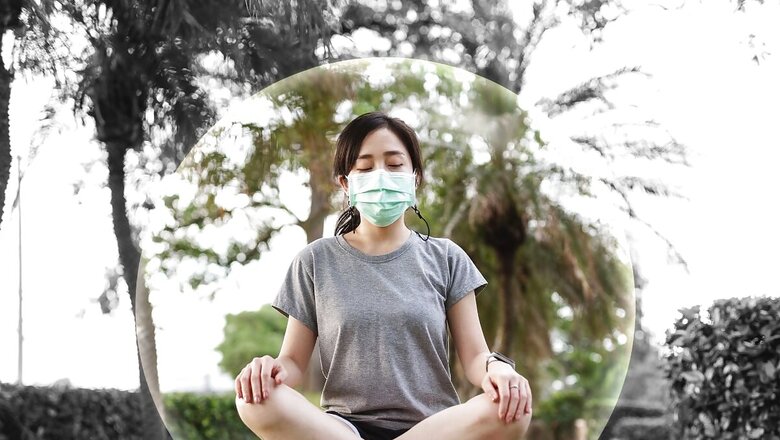
views
Parallelly, there’s Yoga, which delivers benefits that are long-term and sure-shot.
“The air is lacking in oxygen and that is bothering us because our own system is weak. Individuals must develop their systems to such an extent that irritants don’t affect them. It has been proven that once we know how to manage our system, nothing external can bother us. So, learn Yoga techniques,” says Dr Hansa ji Yogendra, director of The Yoga Institute, Santacruz, Mumbai.
YOGA TO CHEMBUR RESIDENTS’ RESCUE
It was the mid-eighties, and the Chembur-Trombay area was known as the Gas Chamber of Mumbai. The source of the severe pollution was emissions from HPCL and BPCL refineries, Tata Power, Rashtriya Chemicals and Fertilisers and other companies. Apart from this, construction work, vehicular traffic, and the presence of Bhabha Atomic Research Centre (BARC) in the vicinity added to locals’ woes.
Scientists in BARC applied to The Yoga Institute one day, asking for help. Reportedly, 82 per cent people living in that area had severe breathing trouble and needed to take medicines on a continuous basis or they would gasp for breath. The situation was serious and doctors’ advice was to leave Mumbai, as that was the only way to remain healthy.
A residential respiratory camp was held at the Yoga Institute where 30 people enrolled themselves. A customised Yoga programme was devised, while the inhalers, bronchodilators and other medication continued. Various Pranayamas, Asanas, guidance on the right diet, ‘Prana management’ with the outside world, right mental state, etc. were all integrated into it. They were made to repeat the techniques till they had mastered them and they were advised to do them systematically and regularly.
Recalls Dr Hansaji, “They returned home and we found that the Yoga techniques had worked wonders with them. They remained free of asthma after that while still right there in the midst of pollution. I am confident that the same formula could be applied to Delhiites and they would be helped by Yoga. Pollution will then not hurt that much.”
REGIMEN TO STRENGTHEN THE RESPIRATORY SYSTEM
Here is an indicative combination of practices and way of life for improving lung capacity and beating pollution woes.
Pranayama: Pranayamas are vital and need to be done regularly. These include Pranayamas to develop vital capacity and strengthen all sets of respiratory muscles — i.e. diaphragmatic, intercostal and clavicular.
‘Equalisation’ of inhalation and exhalation for 3-4 seconds each is the second breathing exercise. This can be extended to long inhalations and exhalations with conscious involvement of all muscles.
The fourth Pranayama is ‘Bhramari’, where the humming creates healing resonance in the body. Finally, there is ‘Anulom-Viloma’ breathing, which creates awareness of both nostrils and ensures both remain open and working.
Special breathing technique for those with pre-existing respiratory disease: Inhale through the nose and forcefully blow out air from the mouth as if blowing out a candle. This aids exhalation and also soothes inflammation in the nasal passage. This can be done for 25-30 rounds.
Asana: Forward-bending asanas like ‘Hastapadasana’ help. ‘Trikonasana’ helps develop clavicular muscles. ‘Konasana variations I and II’ involve intercostal muscles and help increase lung capacity. Try `Sarvangasana’, with the support of a wall, while carrying out abdominal breathing in that position. `Yoga Mudra’ is especially beneficial to help breathe easy.
Remember, all these practices are better learnt in person from a teacher or at an institute, rather than self-learning, which is avoidable.
Diet: Avoid fried items and spicy food as these create extra water requirements in the body, which would add to the imbalance already created by the polluted air.
General helpful tips: Cover the face in high-pollution areas and take short breaths only through the abdomen. Avoid talking much as we tend to breathe through the mouth when we talk. Breathe shallow at traffic signals and in areas with dust and concrete; look out for greenery and breathe in deeply in those areas.
‘LUNGS ARE WEEPING’
Everyone reacts differently to pollution, so not everyone will develop a disease. Those who do get affected severely are those who control emotions rather than release them. Bottling-up emotions in situations where one feels helpless and pent-up anger are the usual causes.
Not getting angry at all is ideal, and Yoga can help to get there gradually. In the short term, diverting emotions into something positive is suggested. Walking and running can help release them; and on days of bad pollution when one can’t step outside, playing games, singing, playing flute, dancing, and other things can bring joy into life.
The author is a journalist, cancer survivor and certified yoga teacher. She can be reached at [email protected].

















Comments
0 comment